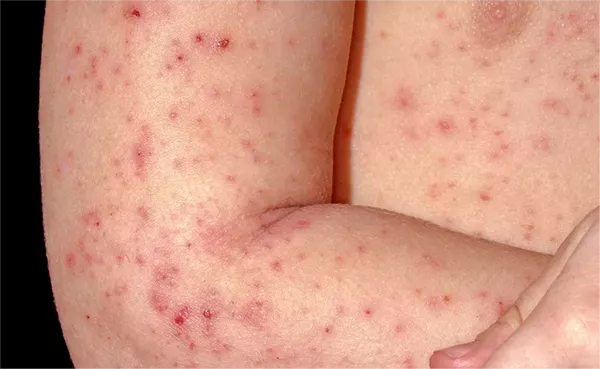Papular eczema, also known as papular dermatitis or chronic papulosquamous dermatosis, is a type of eczema characterized by the presence of papules on the skin. These papules are small, raised bumps that can be red, skin-colored, or inflamed. This condition falls under the broader category of eczema, which encompasses various inflammatory skin conditions causing itchiness, redness, and scaling. Understanding papular eczema involves exploring its symptoms, underlying causes, diagnosis, and effective treatment approaches.
Symptoms of Papular Eczema
The primary symptom of papular eczema is the appearance of papules on the skin. These papules can vary in size and may be distributed over different parts of the body. Other symptoms commonly associated with papular eczema include:
- Itching: Itching is a hallmark of eczema and can be particularly intense with papular eczema due to the presence of numerous papules.
- Redness: The affected areas of the skin can appear red or inflamed due to the underlying inflammation.
- Dryness and Scaling: The skin around the papules may become dry and scaly, especially during flare-ups.
- Thickened Skin: Prolonged irritation and scratching can lead to thickening of the skin (lichenification) in chronic cases.
- Pain and Irritation: In some instances, the skin may become painful or sensitive to touch.
The severity and distribution of symptoms can vary widely among individuals, with some experiencing mild discomfort and others enduring significant distress due to constant itching and skin changes.
Causes of Papular Eczema
The exact cause of papular eczema is not fully understood, but it is believed to result from a combination of genetic, environmental, and immunological factors. Several triggers and risk factors have been identified, including:
1. Genetics: A family history of eczema or atopic dermatitis can increase the likelihood of developing papular eczema.
2. Immune System Dysregulation: Immune system dysfunction plays a role in eczema, leading to excessive inflammation and skin reactions.
3. Environmental Factors: Exposure to allergens, irritants (like harsh soaps or detergents), extreme temperatures, or certain fabrics can trigger or worsen symptoms.
4. Stress: Emotional stress and anxiety can exacerbate eczema symptoms.
5. Microbial Infections: Bacterial or fungal infections of the skin can contribute to the development of papular eczema, especially in cases where the skin barrier is compromised.
Diagnosis of Papular Eczema
Diagnosing papular eczema involves a comprehensive evaluation of the patient’s medical history, symptoms, and a physical examination of the affected skin. In some cases, additional tests may be necessary to rule out other skin conditions or identify triggers. Key steps in the diagnostic process include:
1. Medical History: The dermatologist will inquire about the patient’s personal and family medical history, focusing on any history of eczema or allergic conditions.
2. Physical Examination: A thorough examination of the skin will be conducted to assess the appearance and distribution of papules and other associated symptoms.
3. Patch Testing: In cases where allergic contact dermatitis is suspected, patch testing may be performed to identify specific allergens.
4. Skin Biopsy: In rare cases, a skin biopsy may be recommended to rule out other skin disorders with similar presentations.
Treatment Options for Papular Eczema
Treatment strategies for papular eczema aim to reduce inflammation, alleviate symptoms, and prevent flare-ups. The choice of treatment depends on the severity of symptoms and may include:
- Topical Corticosteroids: These are commonly prescribed to reduce inflammation and itching.
- Topical Calcineurin Inhibitors: These medications are used to suppress the immune response in affected areas.
- Moisturizers: Regular use of emollients helps keep the skin hydrated and prevents dryness.
- Antihistamines: Oral antihistamines can help relieve itching and improve sleep quality.
- Avoidance of Triggers: Identifying and avoiding triggers such as certain fabrics, allergens, or harsh skincare products is essential in managing papular eczema.
- Phototherapy: In severe cases, controlled exposure to ultraviolet (UV) light under medical supervision can be beneficial.
- Systemic Medications: In cases of widespread or severe papular eczema, oral or injectable medications that suppress the immune system may be prescribed.
Living with Papular Eczema: Coping Strategies
Managing papular eczema requires a holistic approach that goes beyond medical treatment. Patients can adopt the following strategies to cope with the condition:
- Skincare Routine: Establishing a gentle skincare routine using hypoallergenic products and avoiding harsh chemicals can help minimize irritation.
- Stress Management: Practicing relaxation techniques such as yoga, meditation, or deep breathing can help reduce stress levels and prevent flare-ups.
- Avoidance of Triggers: Identifying and avoiding triggers such as certain foods, fabrics, or environmental factors is crucial for preventing recurrent episodes.
- Regular Follow-ups: Regular visits to the dermatologist allow for close monitoring of symptoms and adjustments to the treatment plan as needed.
- Support Groups: Joining support groups or online communities can provide valuable emotional support and practical tips for managing eczema.
Conclusion
Papular eczema is a chronic skin condition characterized by the presence of small, raised papules on the skin’s surface. Although it can be challenging to manage, proper diagnosis and treatment can significantly improve symptoms and quality of life. By understanding the causes, symptoms, and available treatment options for papular eczema, individuals affected by this condition can take proactive steps towards effective management and symptom relief. If you suspect that you or a loved one may have papular eczema, seek guidance from a qualified dermatologist for a personalized evaluation and treatment plan. With the right approach, living well with papular eczema is achievable.
Related Topics:

























